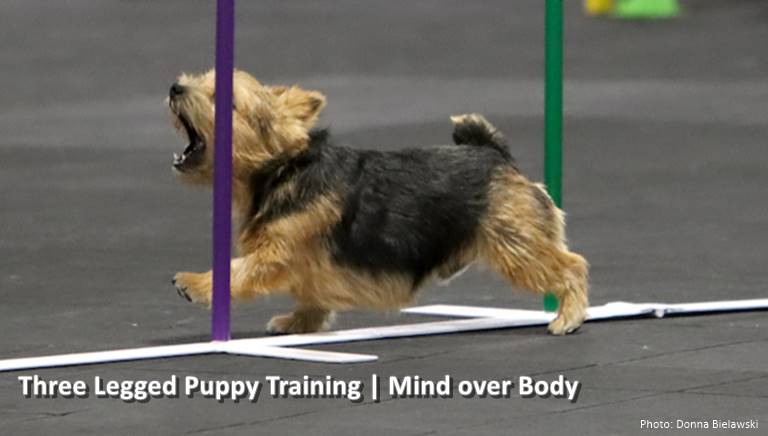Welcome to the world of three legged puppies! These adorable furry friends may have a physical disability, but they are far from disabled in spirit. Training a three legged puppy requires a unique approach that focuses on mind over body. As a pet owner, you need to understand the challenges that come with raising a three legged pup and how to help them overcome those challenges. With the right training and mindset, these puppies can lead happy, active lives just like their four-legged counterparts.
In this article, we’ll explore the best ways to train a three-legged puppy, from building their strength to boosting their confidence. So, whether you’re a new pet owner or a seasoned trainer, get ready to learn how to help your furry friend thrive!
Understanding the Mindset of a Three Legged Puppy
First and foremost, it’s essential to understand the mindset of a 3 legged puppy. They may have a physical disability, but they don’t see themselves as disabled. They are just like any other puppy, full of energy and enthusiasm. However, they may experience frustration and anxiety due to their physical limitations. It’s up to you as a pet owner to help them overcome these challenges.
One way to do that is to create a positive environment. Praise and reward them for their efforts, no matter how small. Encourage them to explore and play, but also be patient if they need to rest. Remember that a three-legged puppy may tire easily, so it’s essential to give them plenty of breaks.
Another way to help your three legged puppy is to socialize them with other dogs. This can help them build confidence and develop their social skills. However, it’s important to introduce them to other dogs slowly and in a controlled environment. Watch their body language and be ready to intervene if necessary.
Finally, remember that your three legged puppy is not defined by their disability. They are still a unique individual with their own personality and quirks. Embrace their differences and celebrate their strengths.
Three Legged Puppy Training
Three legged puppy training requires a unique approach. You need to focus on building their strength and agility while also taking into account their physical limitations. Here are some training techniques that can help:
Use Positive Reinforcement
Positive reinforcement is an effective training technique for all dogs, but it’s especially important for 3 legged puppies. Praise and reward them for their efforts, and use treats to reinforce good behavior. This will help build their confidence and encourage them to keep trying.
Focus on Core Strength
A three legged puppy may struggle with balance and stability. To help them build core strength, try exercises like sit-to-stand or standing on their hind legs. You can also use a balance ball or wobble board to challenge their balance.
Teach Them to Walk on Different Surfaces
Walking on different surfaces can help your three legged puppy build strength and confidence. Start with easy surfaces like carpet or grass and gradually introduce more challenging surfaces like sand or gravel. This will help them develop their balance and coordination.
Don’t Overdo It
While it’s important to challenge your three legged puppy, it’s also essential not to overdo it. They may tire easily, so make sure to give them plenty of breaks. If they show signs of fatigue or discomfort, stop training and let them rest.
3 Legged Puppy Physical Therapy and Exercise
Physical therapy and exercise are essential for three legged puppies. They can help build strength, improve balance and coordination, and prevent muscle atrophy. Here are some exercises for 3 legged puppy that can help:
Swimming
Swimming is an excellent low-impact exercise for three legged puppies. It can help build strength and improve cardiovascular health. However, make sure to supervise them at all times and use a life jacket if necessary.
Treadmill Walking
Treadmill walking can help your three legged puppy build strength and improve their gait. Start with a slow speed and gradually increase it as they get more comfortable. You can also use a harness to support them if necessary.
Massage and Stretching
Massage and stretching can help prevent muscle atrophy and improve circulation. Use gentle strokes and stretches to loosen tight muscles and increase flexibility. This can also be a great way to bond with your furry friend.
Agility Training
Agility training can help your 3 legged puppy build strength, improve balance and coordination, and boost their confidence. Use obstacles like cones, tunnels, and jumps to challenge them and keep them engaged.
Building Confidence and Trust in Your Three Legged Puppy
Building confidence and trust is essential for 3 legged puppies. They may feel anxious or insecure due to their physical limitations, so it’s up to you as a pet owner to help them overcome these challenges. Here are some tips for building confidence and trust:
Set Realistic Goals
Set realistic goals for your three-legged puppy and celebrate their progress. This will help them build confidence and feel more secure in their abilities.
Use a Harness
A harness can help your three legged puppy feel more secure and supported. It can also make it easier to lift them or assist them when necessary.
Be Patient
Training a three-legged puppy takes time and patience. Be patient with them, and don’t get frustrated if they don’t get it right away. Remember to praise and reward them for their efforts, no matter how small.
Build Trust
Building trust is essential for any dog, but it’s especially important for three-legged puppies. Spend time bonding with them and engaging in activities they enjoy. This will help them feel more secure and build trust in you.
Three Legged Puppy Training Common Challenges and Solutions
Training a three-legged puppy comes with its own set of challenges. Here are some common challenges and solutions:
Difficulty with Stairs
Three-legged puppies may struggle with stairs, especially if they have a missing front leg. To help them, you can use a ramp or teach them to crawl up and down the stairs.
Overcompensating
Three-legged puppies may overcompensate for their missing limb by putting too much weight on their remaining legs. This can cause strain and injury. To prevent this, focus on building their core strength and encouraging proper posture.
Prosthetics
Prosthetics can be a great solution for three legged puppies, but they can also be expensive and time-consuming. Consult with your veterinarian to determine if a prosthetic is right for your furry friend.
Pain and Discomfort
Three-legged puppies may experience pain and discomfort due to their physical limitations. It’s essential to monitor them closely for signs of discomfort and consult with your veterinarian if necessary.
Three-Legged Puppy Training Tools and Equipment
There are many tools and equipment available to help with three-legged puppy training. Here are some of the most common:
Harness
A harness can help your three legged puppy feel more secure and supported. It can also make it easier to lift them or assist them when necessary.
Ramps
Ramps can help your three legged puppy navigate stairs, get in and out of vehicles, and access elevated surfaces.
Balance Balls and Wobble Boards
Balance balls and wobble boards can help your three-legged puppy build core strength, improve balance and coordination, and prevent muscle atrophy.
Life Jackets
Life jackets can help your three-legged puppy stay afloat while swimming and provide additional support and buoyancy.
Success Stories of Three Legged Puppy Training
Training a three-legged puppy can be challenging, but it’s also incredibly rewarding. Here are some success stories of three-legged puppies who have thrived with the right training and support:
Tripawds
Tripawds is an online community for three legged dogs and their owners. They provide resources and support to help three-legged dogs lead happy, active lives.
Faith the Dog
Faith the Dog was born in 2002 in Oklahoma, USA, without her two front legs due to a rare congenital condition called canine transverse myelitis. Her owner, Jude Stringfellow, decided to train her to walk on her hind legs. Faith was able to adapt and learn how to walk and run on her hind legs, which became a source of inspiration for many people around the world. She became famous and even appeared on several TV shows
Nubby
Nubby was born without front legs but learned to walk on his hind legs. He was rescued by a family in Texas and learned to walk on his hind legs with the help of a special wheelchair. Nubby’s story went viral, and he became an ambassador for three-legged dogs, raising awareness about their abilities and resilience.
Final Thoughts
Training a three-legged puppy requires a unique approach that focuses on mind over body. By building their strength, boosting their confidence, and providing a positive environment, you can help your furry friend thrive. Remember to celebrate their differences and embrace their strengths. With the right training and mindset, your three legged puppy can lead a happy, active life just like their four legged counterparts.


